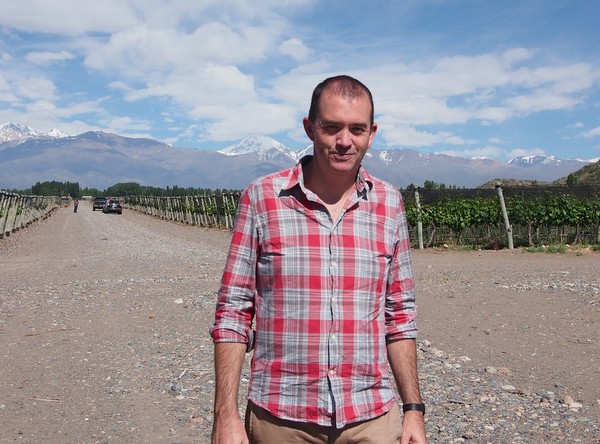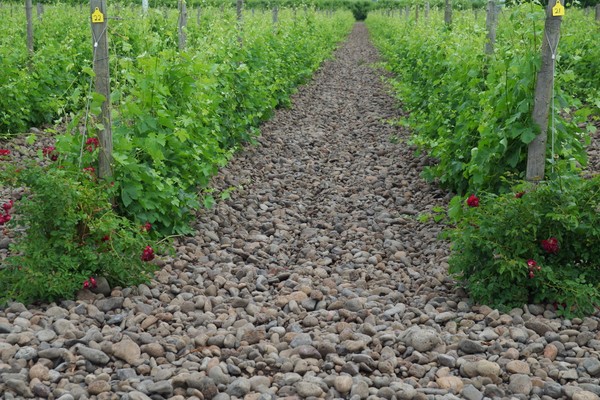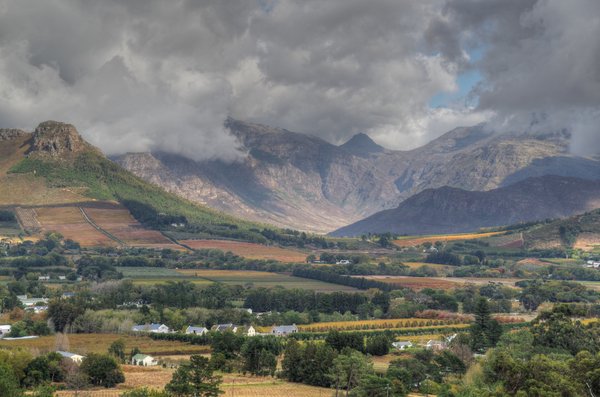|
Developing appellations in emerging regions
Jamie Goode discusses the thorny issue of the
creation of appellations, GIs and AVAs in new world wine countries

The author in
Catena's Adrianna vineyard, in the new Mendoza GI of Gualtallary
I have
been thinking a bit about the process of developing appellations in
new world wine regions. This was a particular issue on my recent
trip to Washington State, and it's becoming an issue in British
Columbia, Canada, which I visited last summer. And when I travelled
to Mendoza, last November, I saw in depth how two new appellations
were being defined in a scientific way. In April this year, I
visited Franschhoek where this is a real hot potato. And it's even
becoming an issue in the UK. As wine regions develop and mature,
it's natural for those involved to want to designate special areas
within those regions as appellations, especially if there are
certain physical characteristics of the area that make it
distinctive, and result in special wines.
There
are a number of things that need to be considered in this process,
and also a number of pitfalls.
Washington State showed the good and bad aspects of this process.
There, the main problem is the potential for massive consumer
confusion, partly because of the lack of any rules governing
labelling regulations. The first issue is the existence of the
Columbia Valley AVA, which is a large AVA that covers over 99% of
the state's wine, pretty much all of which is made east of the
Cascade Mountains. So, some wines have Columbia Valley on the front
label with no mention of Washington State. Others use Washington
State with no mention of the Columbia Valley. Where is the brand
equity being built? I also saw bottles with sub AVAs on the front
label – one example was Red Mountain – without any mention of
Columbia Valley or Washington State.
I did
wonder whether it might have suited some of the larger companies to
have the origin of their wines made less than obvious. To most
American consumers, a wine from Columbia Valley looks like it is
made in California, and in the past – when Washington State had less
brand equity – this might have been helpful. They might argue,
though, that putting Washington on the label would suggest to many
consumers that the wine comes from the other side of the country
(“which side of the Potomac do you grow your grapes”). Either way,
it's an undesirable situation. There should be a legal requirement
for how AVAs (and nested AVAs) are displayed on the label.
Then
there's the issue of how AVAs (or other, similar appellations) are
decided. Is it just political boundaries? This is fairly
uncontroversial, in that if your vineyard is located within a
geographical area, then you can say that the resulting wine is from
that area. It's simply label integrity. But there's little point for
such AVAs, unless of course by happy chance the political boundaries
also align with physical characteristics of soils, climates or
aspect that result in distinctive wines. In this sort of situation,
can’t you just indicate where the wine is from without the need for
an AVA?

The distinctive soils of the
new Rocks AVA, Walla Walla
In
Washington State, there's also the bizarre situation where one of
the main AVAs is shared among two states. Walla Walla is part in
Washington State and part in Oregon. The Oregon bit really doesn't
fit with the rest of Oregon, so there are examples of wineries
hopping over the state boundary just because it's hard for them to
get any traction as an Oregon producer. The newest Walla Walla
sub-AVA is actually a great example of how to define an AVA that
makes sense, in that it is done solely on soil type. It's called the
Rocks, or, to give it its full name, the Rocks District of Millton
Freewater. It is a pretty homogeneous AVA, with 97% of the 4000
acres sharing the same soil type. It’s basically an alluvial fan of
the Walla Walla River, where the river leaves the Blue Mountains and
enters the Walla Walla Valley. Rocks is entirely in Oregon, but is
part of the Walla Walla AVA, which is shared between Oregon and
Washington State. Currently there are 300 acres planted. The reason
this AVA makes so much sense is that you can look down at the soil
and see the boundary. And you can taste the effects of these soils
in the wines.
When I
visited Catena in Argentina last year, they showed the process that
scientists had gone through to establish two new appellations in
Mendoza, with the first of these, Gualtallary, now having been
granted a GI (geographical indication). The setting of the
boundaries had been established on the basis of some fairly in-depth
science, showing that they made sense, and also that vineyards
located within the boundaries would be significantly different to
those outside.
Should
new world appellations have a raft of restrictions allied to them,
just as they do in Europe? If you want to use an appellation name in
Euopean regions, you need to use proscribed grape varieties, and
also meet yield requirements (although these might be fluid, as in
Champagne), and possibly further rules designed to guarantee
quality. I think the answer is yes and no. To me it makes little
sense that grape varieties aren't considered in appellation rules in
the new world. It may be that certain places just have an amazing
talent for, say Riesling. So restrict the AVA or appellation to
Riesling for that place and it suddenly becomes very interesting. Of
course growers can plant other things, it's just that they have to
use the broader appellation. It helps build brand equity for the
new, tighter sub-appellation if it is reserved for wines of special
character. Of course, you don't want to move too early to this sort
of system, and it's only worth doing if a region has a genuine
talent for the variety or varieties in question. But it has real
potential for growing the international reputation of a region. The
big challenge: getting stakeholders to agree. As for restrictions on
yield and so on, I am not sure whether these actually result in
better wines. So I would avoid them.

Franschhoek
I have
been really interested by the situation in Franschhoek, South
Africa. On the one hand we see there a political move to expand the
Franschhoek WO boundaries to include the Paarl Simonsberg ward,
which seems ill-advised but will probably make some people quite a
bit of money. On the other hand we have the desire to create one of
the new world's tightest appellation systems, with Appellation Grand
Prestige (AGP). This is for wines grown in Franschhoek WO from
Semillon, Chardonnay and Cabernet Sauvignon only, because the guys
behind it thought that these were Franschhoek's strong points. In
the inaugural year, just a handful of examples of each passed the
typicity taste test, so this is almost a half-way house between an
appellation and a competition. It’s not a perfect system, but it is
a really intriguing and well thought out initiative.
What
about tasting tests? Should AVAs get a panel of tasters together to
see whether the wines pass muster? This sounds like a good idea, but
it is fraught with problems. Who are the tasters? How good are they?
Are they tasting from a winemaker's perspective, or a consumer's?
This big problem comes when perfectly sale-able wines made in an
unorthodox style get failed. This happened several times with Pearl
Morissette's Riesling from Niagara, Canada. The VQA tasting panel
kept failing it, even though it's a lovely wine with a strong fan
base. Normally, a grower could just declassify. But with the Ontario
VQA, if you don't pass you face a serious financial hit in terms of
lost tax breaks, so declassification is potentially ruinous.
There
needs to be protection for appellation names. Look at the situation
with the Waipara Valley in North Canterbury, New Zealand, where
there are at least three wineries with ‘Waipara’ in their name.
Ideally, wineries shouldn't be able to use an appellation name in
their own name. In addition, it should be illegal for people to put
the name of an appellation or AVA or WO on the label unless that
wine is part of it, to avoid consumer confusion.
This
brings me round to the important point on consumer confusion.
Consumers are confused enough when it comes to wine, and the
profusion of appellation names only serves to make this worse. So
there should be a lot of caution about creating new sub-AVAs or
appellations unless the distinctive character of a viticultural
area, expressed in the wine, really demands it. The problem is that
these new regions are seen as a badge of honour and a ticket to
higher prices, and so people have a motivation to create them, even
if they are more-or-less meaningless. The creation of a PDO for an
English county, Sussex, to include both still and sparkling wines,
is a case in point. There's no justification for it on the basis of
terroir. The proposed rules may be tighter than existing ones, but
they won't guarantee quality. The net result is an extra layer of
complication for consumers. You can already put Sussex on your label
if you make the wine there. There's nothing special about Sussex
compared with neighbouring counties. So what really is the point?
So, to
conclude, identifying special vineyard areas within emerging regions
is part of the development of any wine industry. I think there needs
to be a justification on the basis of physical features of any
proposed appellation, rather than just the banding together of
producers within established political boundaries. The proposal
needs to spell out how these boundaries were defined or else they
will later be subject to challenge, especially if there is a
financial motivation for their expansion. It makes sense to award
the appellation only to certain grape varieties that the proposed
area has a special talent for. And I think great caution should be
taken in setting up these appellations, because there's no going
back once they are in place.
See
also:
 Is
noble wine a valid concept? Is
noble wine a valid concept?
 Export
approval: How natural winegrowers in the new world can run into
difficulties exporting their wines Export
approval: How natural winegrowers in the new world can run into
difficulties exporting their wines
Back
to top
|

